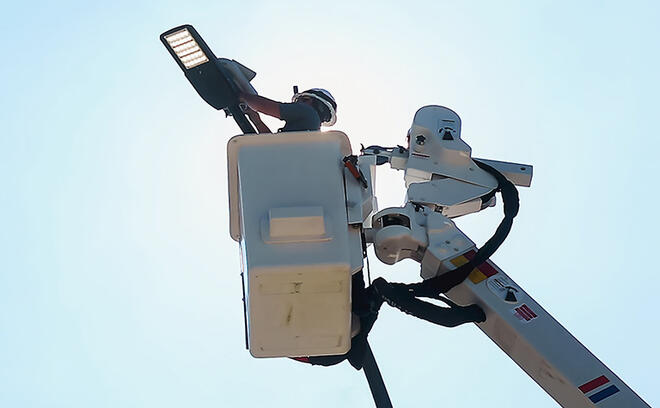Using Streetlights to Boost 5G Deployments in Cities

Image courtesy of AT&T
AT&T Blog, Gordon Mansfield, 2.25.22
Creative new solution turns streetlights into 5G sites in as little as 15 minutes with zero footprint, efficiently boosting 5G experiences in dense, urban environments.
Ever notice new poles popping up with strange boxes and wires strung about along some streets? It’s most likely a 5G small cell site. These access points help deliver mobile data to a localized area, powering the connections you rely on for everything from a video conference on the go to streaming your favorite team in the playoffs.
With ever-growing capabilities and sizeable shift in connectivity trends at home and on the go, it’s no surprise that data consumption and demand for high-speed connections has surged over the last few years. Keeping pace means continued expansion and enhancement of the network, including more 5G small cell sites in areas where you live, work and play.
One of the most significant challenges network operators face in deploying new mobile network infrastructure is the time it takes to work through the process of acquiring sites, engineering designs, and securing permits – and that’s all before construction even begins. Across the industry adding new 5G locations can take anywhere from 12 to 18 months on average, which also means it’s ripe for innovative solutions.
Continuous process improvement is in our blood as engineers. Pushing the traditional options for how 5G is deployed is exactly what inspired the question and idea nearly three years ago that I posed to smart solution provider Ubicquia: Why not plug 5G radios into streetlights? We quickly connected with global equipment provider Ericsson and the concept for the Ericsson Street Radio 4402 was born.
Nearly Invisible 5G Sites
The ultra-compact, fully integrated Ericsson Street Radio small cell can be deployed globally by plugging into existing streetlights that utilize a National Electrical Manufacturers Association (NEMA) standardized connector. And it is virtually unseen from street level. The device sits just above the streetlight shield next to the light itself allowing it to blend into the existing infrastructure. No long wires and big, bulky boxes – a true aesthetic improvement. And in many cases the installation can be completed within just 15 minutes, transforming a streetlight into a low- or mid-band 5G site.
Streetlights are also the perfect deployment point for meeting network infrastructure densification needs because they are typically 8 to 10 meters high, spaced 50 meters apart, have an existing power supply and are within close proximity to fiber. By using existing infrastructure, this solution reduces costs, streamlines site approval and permitting, and speeds installation. These radios also have smart sensors that allow us to detect failed or downed streetlights in the event of a storm, blackout, or other disruptive event. This helps us in quickly assessing damage and dispatching crews for repairs or alerting the power provider of an issue.
On the Horizon
Just how promising is this new solution? Street Radio prototypes were trialed last year, and we are now in the process of field testing and deploying commercially available units in multiple cities – meaning this unique solution is poised to help accelerate 5G deployments across the country on the most reliable 5G network in America, AT&T 5G.1
One of the most fulfilling parts of my job is creating access in areas lacking coverage. Because this unique, compact solution uses existing infrastructure, it could play a role in helping bring5G to some underserved areas and further meet our company commitment to closing the digital divide.
Although jointly pioneered for our network, other operators will be able to utilize the technology in the future, further benefiting the entire industry. This project was nominated by the Global Mobile (GLOMO) Awards in Barcelona for “Best Mobile Network Infrastructure.”
1Based on nationwide GWS drive test data. GWS conducts paid drive tests for AT&T and uses the data in its analysis. AT&T 5G requires compatible plan and device. 5G is not available everywhere. Go to att.com/5Gforyou for details

